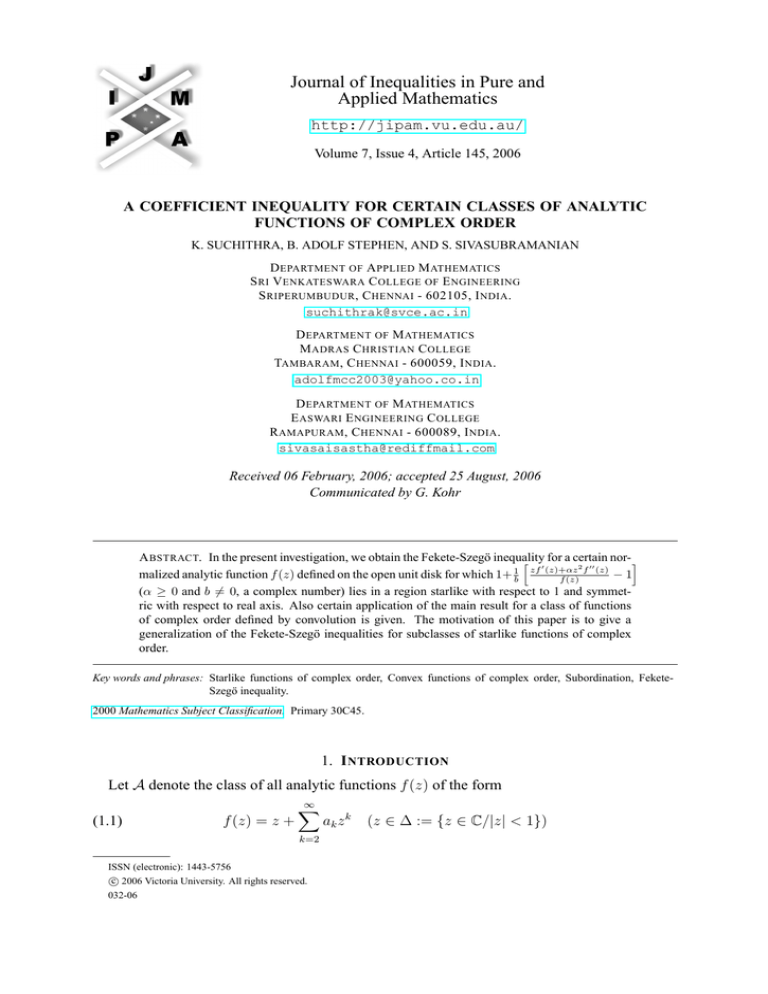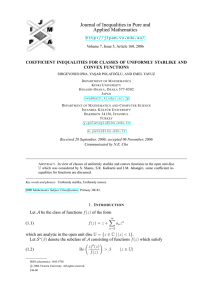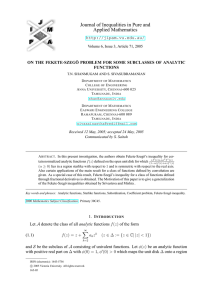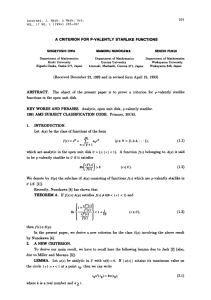
Journal of Inequalities in Pure and
Applied Mathematics
http://jipam.vu.edu.au/
Volume 7, Issue 4, Article 145, 2006
A COEFFICIENT INEQUALITY FOR CERTAIN CLASSES OF ANALYTIC
FUNCTIONS OF COMPLEX ORDER
K. SUCHITHRA, B. ADOLF STEPHEN, AND S. SIVASUBRAMANIAN
D EPARTMENT OF A PPLIED M ATHEMATICS
S RI V ENKATESWARA C OLLEGE OF E NGINEERING
S RIPERUMBUDUR , C HENNAI - 602105, I NDIA .
suchithrak@svce.ac.in
D EPARTMENT OF M ATHEMATICS
M ADRAS C HRISTIAN C OLLEGE
TAMBARAM , C HENNAI - 600059, I NDIA .
adolfmcc2003@yahoo.co.in
D EPARTMENT OF M ATHEMATICS
E ASWARI E NGINEERING C OLLEGE
R AMAPURAM , C HENNAI - 600089, I NDIA .
sivasaisastha@rediffmail.com
Received 06 February, 2006; accepted 25 August, 2006
Communicated by G. Kohr
A BSTRACT. In the present investigation, we obtain the Fekete-Szegö inequality
nor- i
h 0 for a certain
2 00
1 zf (z)+αz f (z)
malized analytic function f (z) defined on the open unit disk for which 1+ b
−1
f (z)
(α ≥ 0 and b 6= 0, a complex number) lies in a region starlike with respect to 1 and symmetric with respect to real axis. Also certain application of the main result for a class of functions
of complex order defined by convolution is given. The motivation of this paper is to give a
generalization of the Fekete-Szegö inequalities for subclasses of starlike functions of complex
order.
Key words and phrases: Starlike functions of complex order, Convex functions of complex order, Subordination, FeketeSzegö inequality.
2000 Mathematics Subject Classification. Primary 30C45.
1. I NTRODUCTION
Let A denote the class of all analytic functions f (z) of the form
(1.1)
f (z) = z +
∞
X
k=2
ISSN (electronic): 1443-5756
c 2006 Victoria University. All rights reserved.
032-06
ak z k
(z ∈ ∆ := {z ∈ C/|z| < 1})
2
K. S UCHITHRA , B. A DOLF S TEPHEN , AND S. S IVASUBRAMANIAN
and S be the subclass of A consisting of univalent functions. Let φ(z) be an analytic function
with positive real part on ∆ with φ(0) = 1, φ0 (0) > 0 which maps the unit disk ∆ onto a region
starlike with respect to 1 which is symmetric with respect to the real axis. Let S ∗ (φ) be the class
of functions in f ∈ S for which
zf 0 (z)
≺ φ(z), (z ∈ ∆)
f (z)
and C(φ) be the class of functions f ∈ S for which
1+
zf 00 (z)
≺ φ(z), (z ∈ ∆),
f 0 (z)
where ≺ denotes the subordination between analytic functions. These classes were introduced
and studied by Ma and Minda [4]. They have obtained the Fekete-Szegö inequality for functions
in the class C(φ). Since f ∈ C(φ) iff zf 0 (z) ∈ S ∗ (φ), we get the Fekete-Szegö inequality for
functions in the class S ∗ (φ).
The class Sb∗ (φ) consists of all analytic functions f ∈ A satisfying
1 zf 0 (z)
1+
− 1 ≺ φ(z)
b
f (z)
and the class Cb (φ) consists of functions f ∈ A satisfying
1 zf 00 (z)
1+
≺ φ(z).
b f 0 (z)
These classes were defined and studied by Ravichandran et al. [7]. They have obtained the
Fekete-Szegö inequalities for functions in these classes.
For a brief history of the Fekete-Szegö problem for the class of starlike, convex and close to
convex functions, see the recent paper by Srivastava et al. [10].
In the present paper, we obtain the Fekete-Szegö inequality for functions in a more general
class Mα,b (φ) of functions which we define below. Also we give applications of our results
to certain functions defined through convolution (or Hadamard product) and in particular we
λ
consider a class Mα,b
(φ) of functions defined by fractional derivatives.
Definition 1.1. Let b 6= 0 be a complex number. Let φ(z) be an analytic function with positive
real part on ∆ with φ(0) = 1, φ0 (0) > 0 which maps the unit disk ∆ onto a region starlike with
respect to 1 which is symmetric with respect to the real axis. A function f ∈ A is in the class
Mα,b (φ) if
1 zf 0 (z) + αz 2 f 00 (z)
− 1 ≺ φ(z) (α ≥ 0).
1+
b
f (z)
g
For fixed g ∈ A, we define the class Mα,b
(φ) to be the class of functions f ∈ A for which
(f ∗ g) ∈ Mα,b (φ).
To prove our result, we need the following:
Lemma 1.1 ([7]). If p(z) = 1 + c1 z + c2 z 2 + · · · is a function with positive real part, then for
any complex number µ,
|c2 − µc21 | ≤ 2 max{1, |2µ − 1|}
and the result is sharp for the functions given by
p(z) =
J. Inequal. Pure and Appl. Math., 7(4) Art. 145, 2006
1 + z2
,
1 − z2
p(z) =
1+z
.
1−z
http://jipam.vu.edu.au/
C LASSES O F A NALYTIC F UNCTIONS O F C OMPLEX O RDER
3
2. T HE F EKETE -S ZEGÖ P ROBLEM
Our main result is the following:
Theorem 2.1. Let φ(z) = 1 + B1 z + B2 z 2 + B3 z 3 + · · · . If f (z) given by (1.1) belongs to
Mα,b (φ), then
B2
B1 |b|
(1
+
2α)
−
2µ(1
+
3α)
2
|a3 − µa2 | ≤
max 1, +
bB1 .
2
2(1 + 3α)
B1
(1 + 2α)
The result is sharp.
Proof. If f (z) ∈ Mα,b (φ), then there is a Schwarz function w(z), analytic in ∆ with w(0) = 0
and |w(z)| < 1 in ∆ such that
1 zf 0 (z) + αz 2 f 00 (z)
(2.1)
1+
− 1 = φ(w(z)).
b
f (z)
Define the function p1 (z) by
(2.2)
p1 (z) :=
1 + w(z)
= 1 + c1 z + c2 z 2 + · · · .
1 − w(z)
Since w(z) is a Schwarz function, we see that Rp1 (z) > 0 and p1 (0) = 1. Define the function
p(z) by
1 zf 0 (z) + αz 2 f 00 (z)
− 1 = 1 + b1 z + b2 z 2 + · · · .
(2.3)
p(z) := 1 +
b
f (z)
In view of the equations (2.1), (2.2), (2.3), we have
p1 (z) − 1
(2.4)
p(z) = φ
p1 (z) + 1
and from this equation (2.4), we obtain
1
b1 = B1 c1
2
(2.5)
and
(2.6)
1
1 2
1
b2 = B1 c2 − c1 + B2 c21 .
2
2
4
From equation (2.3), we obtain
(1 + 2α)a2 = bb1 ,
(2 + 6α)a3 = bb2 + (1 + 2α)a22
or equivalently we have
a2 =
(2.7)
(2.8)
bb1
,
1 + 2α
1
b2 b21
a3 =
bb2 +
.
2 + 6α
1 + 2α
J. Inequal. Pure and Appl. Math., 7(4) Art. 145, 2006
http://jipam.vu.edu.au/
4
K. S UCHITHRA , B. A DOLF S TEPHEN , AND S. S IVASUBRAMANIAN
Applying (2.5) in (2.7) and (2.5), (2.6) in (2.8), we have
bB1 c1
a2 =
,
2(1 + 2α)
2 2
b B1
bB1 c2
c21
a3 =
+
− b(B1 − B2 ) .
4(1 + 3α) 8(1 + 3α) 1 + 2α
Therefore we have
bB1
c2 − vc21 ,
(2.9)
a3 − µa22 =
4(1 + 3α)
where
2µ(1 + 3α) − (1 + 2α)
1
B2
v :=
1−
+
bB1 .
2
B1
(1 + 2α)2
Our result now follows by an application of Lemma 1.1. The result is sharp for the function
defined by
1 zf 0 (z) + αz 2 f 00 (z)
1+
− 1 = φ(z 2 )
b
f (z)
and
1 zf 0 (z) + αz 2 f 00 (z)
1+
− 1 = φ(z).
b
f (z)
Example 2.1. By taking b = (1 − β)e−iλ cos λ, φ(z) =
inequality
|a3 − µa22 | ≤
1+z
,
1−z
we obtain the following sharp
(1 − β) cos λ
1 + 3α iλ
2µ(1
+
3α)
−
(1
+
2α)
.
(1
−
β)
cos
λ
× max 1, e − 2
(1 + 2α)2
Remark 2.2. When α = 0, Example 2.1 reduces to a result of [7] for λ-spirallike function f (z)
of order β.
3. A PPLICATION TO F UNCTIONS D EFINED BY F RACTIONAL D ERIVATIVES
λ
In order to introduce the class Mα,b
(φ), we need the following:
Definition 3.1. (See [5, 6]; see also [11, 12]). Let the function f (z) be analytic in a simply
connected region of the z-plane containing the origin. The fractional derivative of f of order λ
is defined by
Z z
1
d
f (ζ)
λ
Dz f (z) :=
dζ (0 ≤ λ < 1)
Γ(1 − λ) dz 0 (z − ζ)λ
where the multiplicity of (z − ζ)λ is removed by requiring log(z − ζ) to be real when z − ζ > 0.
Using the above Definition 3.1 and its known extensions involving fractional derivatives and
fractional integrals, Owa and Srivastava [5] introduced the operator Ωλ : A → A defined by
(Ωλ f )(z) = Γ(2 − λ)z λ Dzλ f (z), (λ 6= 2, 3, 4, . . . ).
λ
0
The class Mα,b
(φ) consists of functions f ∈ A for which Ωλ f ∈ Mα,b (φ). Note that M0,b
(φ) =
g
0
λ
Sb∗ (φ) and M0,1
(φ) = S ∗ (φ). Also Mα,b
(φ) is the special case of the class Mα,b
(φ) when
(3.1)
g(z) = z +
∞
X
Γ(n + 1)Γ(2 − λ)
n=2
J. Inequal. Pure and Appl. Math., 7(4) Art. 145, 2006
Γ(n + 1 − λ)
zn.
http://jipam.vu.edu.au/
C LASSES O F A NALYTIC F UNCTIONS O F C OMPLEX O RDER
5
Let
g(z) = z +
∞
X
gn z n (gn > 0).
n=2
Since
f (z) = z +
∞
X
g
an z n ∈ Mα,b
(φ)
n=2
if and only if
(f ∗ g)(z) = z +
∞
X
gn an z n ∈ Mα,b (φ),
n=2
g
we obtain the coefficient estimate for functions in the class Mα,b
(φ), from the corresponding
estimate for functions in the class Mα,b (φ). Applying Theorem 2.1 for the function (f ∗ g)(z) =
z+g2 a2 z 2 +g3 a3 z 3 +· · · , we get the following theorem after an obvious change of the parameter
µ:
Theorem 3.1. Let the function φ(z) be given by φ(z) = 1 + B1 z + B2 z 2 + B3 z 3 + · · · . If f (z)
g
given by (1.1) belongs to Mα,b
(φ), then
2
B
(1
+
2α)g
−
2µ(1
+
3α)g
B
|b|
2
3
1
2
.
max 1, +
bB
|a3 − µa22 | ≤
1
2g3 (1 + 3α)
B1
(1 + 2α)2 g22
The result is sharp.
Since
(Ωλ f )(z) = z +
∞
X
Γ(n + 1)Γ(2 − λ)
n=2
Γ(n + 1 − λ)
an z n ,
we have
g2 =
(3.2)
Γ(3)Γ(2 − λ)
2
=
Γ(3 − λ)
2−λ
and
g3 =
(3.3)
Γ(4)Γ(2 − λ)
6
=
.
Γ(4 − λ)
(2 − λ)(3 − λ)
For g2 and g3 given by (3.2) and (3.3), Theorem 3.1 reduces to the following:
Theorem 3.2. Let the function φ(z) be given by φ(z) = 1 + B1 z + B2 z 2 + B3 z 3 + · · · . If f (z)
λ
given by (1.1) belongs to Mα,b
(φ), then
|a3 − µa22 | ≤
B1 |b|(2 − λ)(3 − λ)
12(1 + 3α)
B2
(1
+
2α)(3
−
λ)
−
3µ(1
+
3α)(2
−
λ)
× max 1, +
bB1 .
2
B1
(3 − λ)(1 + 2α)
The result is sharp.
J. Inequal. Pure and Appl. Math., 7(4) Art. 145, 2006
http://jipam.vu.edu.au/
6
K. S UCHITHRA , B. A DOLF S TEPHEN , AND S. S IVASUBRAMANIAN
R EFERENCES
[1] B.C. CARLSON AND D.B. SHAFFER, Starlike and prestarlike hypergeometric functions, SIAM J.
Math. Anal., 15 (1984), 737–745.
[2] A.W. GOODMAN, Uniformly convex functions, Ann. Polon. Math., 56 (1991), 87–92.
[3] F.R. KEOGH AND E.P. MERKES, A coefficient inquality for certain classes of analytic functions,
Proc. Amer. Math. Soc., 20 (1969), 8–12.
[4] W. MA AND D. MINDA, A unified treatment of some special classes of univalent functions, in:
Proceedings of the conference on Complex Analysis, Z. Li, F. Ren, L. Yang and S. Zhang (Eds.),
Int. Press (1994), 157–169.
[5] S. OWA AND H.M. SRIVASTAVA, Univalent and starlike generalized hypergeometric functions,
Canad. J. Math., 39 (1987), 1057–1077.
[6] S. OWA, On the distortion theorems I, Kyungpook Math. J., 18 (1978), 53–58.
[7] V. RAVICHANDRAN, METIN BOLCAL, YASAR POLATOGLU AND A. SEN, Certian subclasses of Starlike and Convex functions of Complex Order, Hacettepe Journal of Mathematics
and Statistics, 34 (2005), 9-15.
[8] F. RØNNING, Uniformly convex functions and a corresponding class of starlike functions, Proc.
Amer. Math. Soc., 118 (1993), 189–196.
[9] T.N. SHANMUGAM, S. SIVASUBRAMANIAN AND M. DARUS, Fekete-Szegö inequality for a
certain class of analytic functions, Preprint.
[10] H.M. SRIVASTAVA, A.K. MISHRA AND M.K. DAS, The Fekete-Szegö problem for a subclass of
close-to-convex functions, Complex Variables, Theory Appl., 44 (2001), 145–163.
[11] H.M. SRIVASTAVA
(1984), 383–389.
AND
S. OWA, An application of the fractional derivative, Math. Japon., 29
[12] H.M. SRIVASTAVA AND S. OWA, Univalent functions, Fractional Calculus, and their Applications, Halsted Press / John Wiley and Sons, Chichester / New York, (1989).
J. Inequal. Pure and Appl. Math., 7(4) Art. 145, 2006
http://jipam.vu.edu.au/









